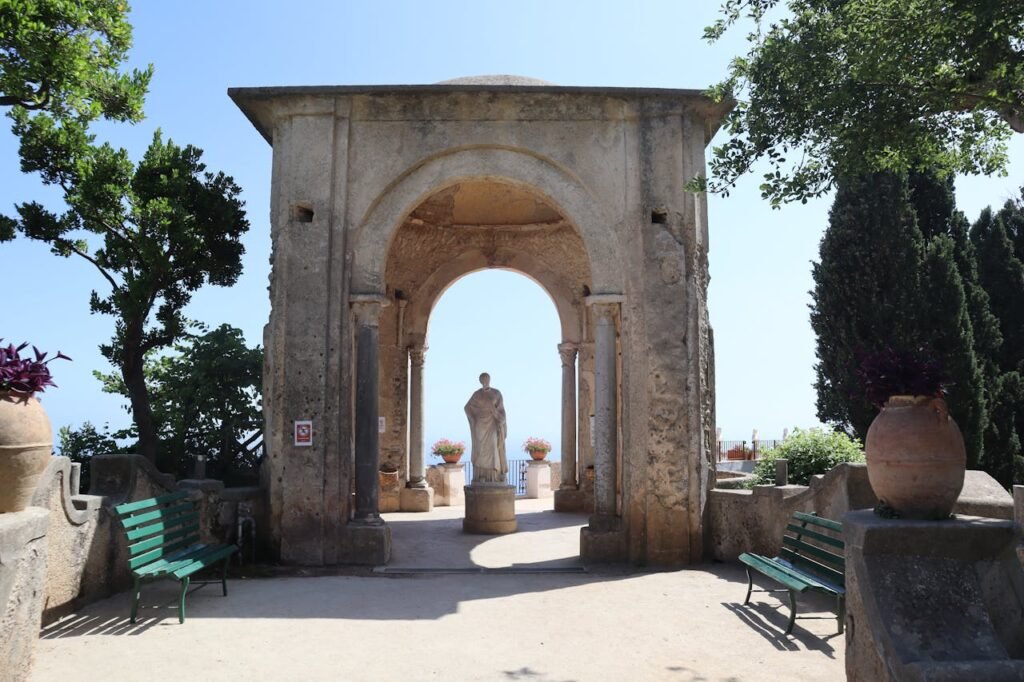Bologna isn’t just another Italian city – it’s a vibrant blend of medieval architecture, world-class cuisine, and student energy that’ll completely change how you think about Italian travel.
Bologna is home to the world’s oldest university and produces over 80% of Italy’s mortadella.
Whether you’re a first-time visitor or returning to discover what’s new in 2025, then guide for you because in this guide you will work through top 10 things to do in Bologna, italy.
From climbing ancient towers to learning pasta-making secrets from local nonnas, this guide will help you make the most of your time in Italy’s most underrated city.
1. Climb the Iconic Two Towers (Asinelli and Garisenda)
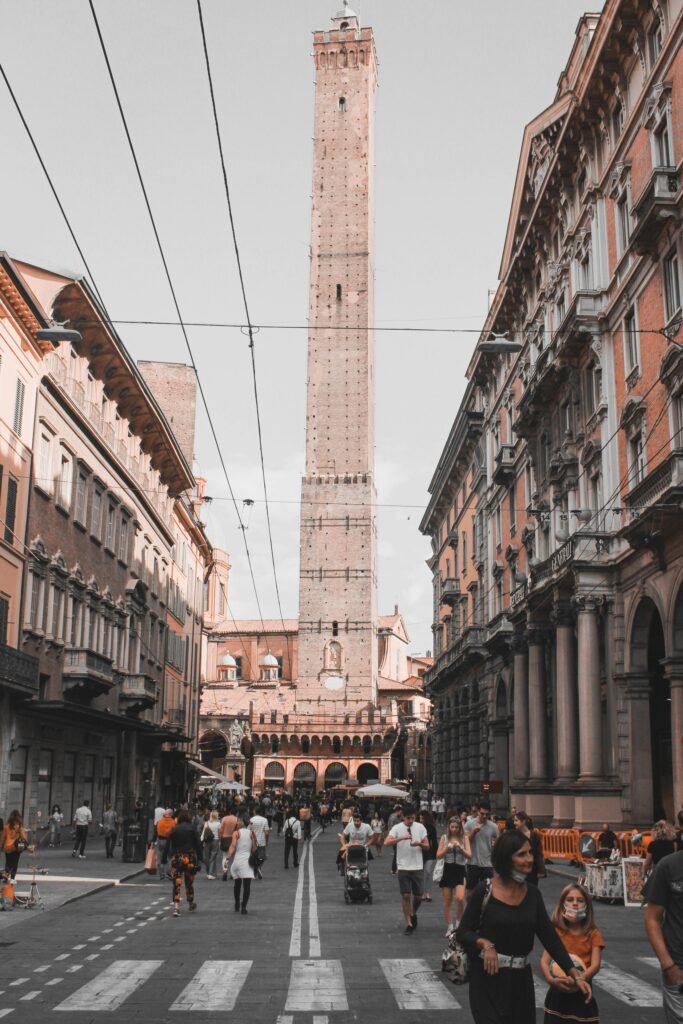
I didn’t know I was afraid of heights until I was 200 steps up the Asinelli Tower, gripping the medieval railing like it might dissolve.
But those 498 steps? So worth it.
These towers have stood since the 12th century, and the view from the top is Bologna’s ultimate reward: a sea of red rooftops, terracotta hues, and that feeling of stepping into an ancient map.
Pro tip: In 2025, you need to book your spot online in advance. Trust me — the one-hour wait I endured during peak season was not romantic.
The climb is tight, creaky, and medieval. People turn back. I nearly did.
But if you make it to the top during golden hour? You’ll understand why locals still say “Bologna la rossa” with pride.
Ticket Info: Adults €8, reduced €6. Reserve tickets in advance through Bologna’s official tourism portal.
2. Explore the Quadrilatero Food Market District
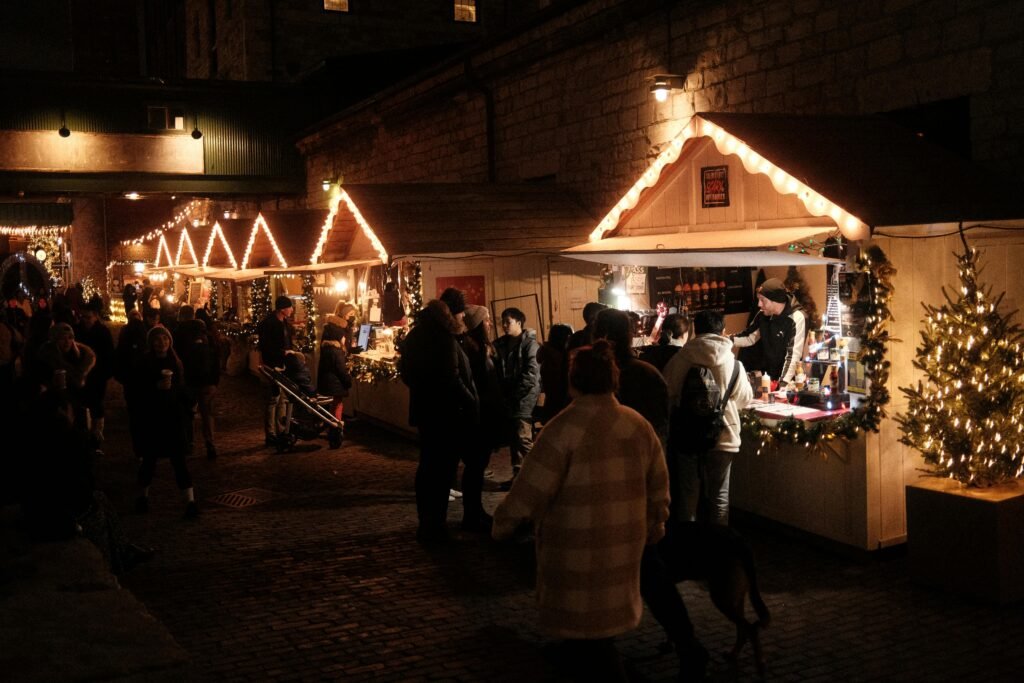
If you’re a foodie like me, the Quadrilatero is going to be your happy place.
This ancient market district has been feeding Bologna for over 900 years, and walking through it feels like stepping back in time.
The narrow medieval streets are packed with tiny shops selling everything from 24-month aged Parmigiano Reggiano to mortadella so fresh it’s still warm.
My biggest rookie mistake was not bringing cash.
Most of the smaller vendors still prefer cash payments, and I ended up having to find an ATM mid-shopping spree.
The star of the show is definitely the mortadella.
I thought I knew what mortadella was until I tried the real thing here. It’s nothing like what you find in American delis – it’s silky, flavorful, and completely changes your perspective on Italian cured meats.
Best Time to Visit: Tuesday through Saturday mornings (10 AM – 1 PM) when it’s most lively. Keep in mind that most local shops shut on Sundays and Monday mornings.
3. Take a Pasta Making Class with Local Chefs
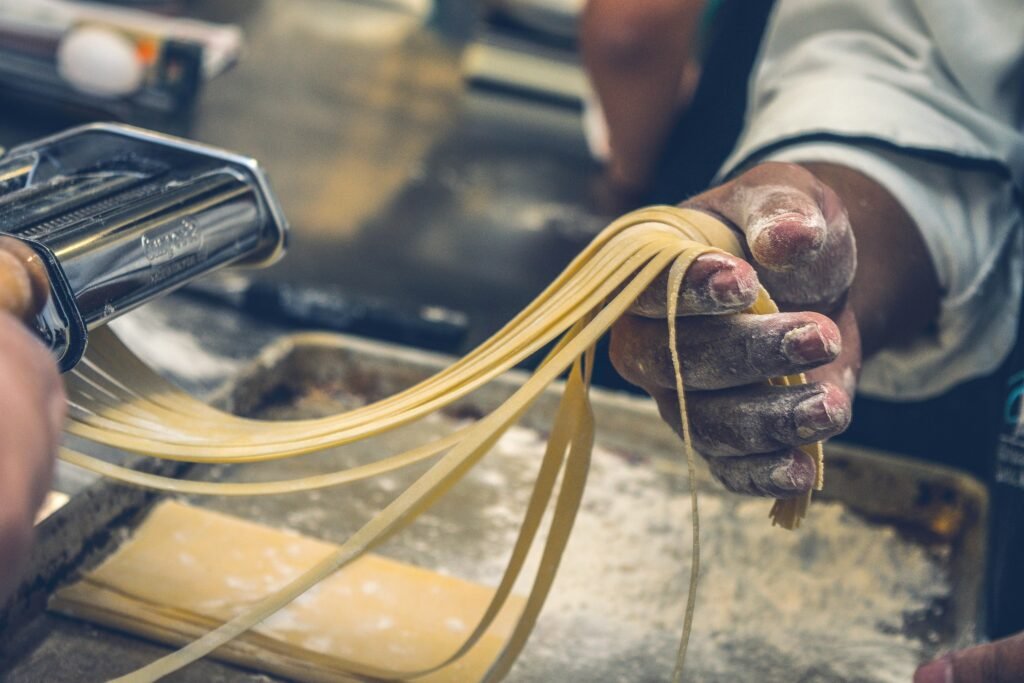
Okay, confession time: I used to think making fresh pasta was this incredibly complicated process that only Italian grandmothers could master.
Then I took a class in Bologna and realized I’d been living a lie!
La Vecchia Scuola Bolognese is where I learned to make proper tagliatelle, and it completely changed my perspective on Italian cooking.
The class starts with learning about the different types of flour and eggs used in traditional Bologna pasta.
Who knew there were so many variables? We made tagliatelle from scratch, and I’ll be honest – my first attempts looked more like thick noodles than delicate pasta ribbons.
The best part? You get to eat everything you make, paired with traditional Bolognese sauce that simmers for hours.
I’ve never tasted pasta that fresh before, and it ruined me for store-bought pasta forever.
Most classes run about 3-4 hours and include wine (thank goodness, because I needed it after my pasta-rolling disasters).
Pro Tips: Reserve at least a week in advance, especially during peak season. Classes typically cost €85-120 per person and often include lunch. Click here to know Why You Shouldn’t Cut Tagliatelle the Wrong Way in Bologna.
4. The Magnificent Basilica of San Petronio

San Petronio is one of those places that makes you feel tiny in the best possible way.
This massive Gothic basilica dominates Piazza Maggiore, and fun fact – it was originally planned to be larger than St. Peter’s Basilica in Rome!
The unfinished facade tells an incredible story.
Construction began in 1390, but political pressure from the Vatican meant it was never completed.
I made the mistake of rushing through on my first visit, but this church deserves at least an hour of your time. The interior is absolutely massive – it’s the 10th largest church in the world.
The chapel decorations are stunning, especially the frescoes in the Bolognini Chapel. The scenes of heaven and hell are incredibly detailed and a bit terrifying if you stare too long.
Don’t miss the wooden choir stalls – they’re carved with incredible detail and show scenes from Bologna’s history. The craftsmanship is absolutely mind-blowing when you consider they were carved in the 15th century.
Visiting Tips: Free entry, but donations are appreciated. Dress modestly (no shorts or tank tops), and be respectful of worshippers. Visiting hours are typically from 7:45 AM to 6:30 PM daily.
5. Wander Through the University Quarter
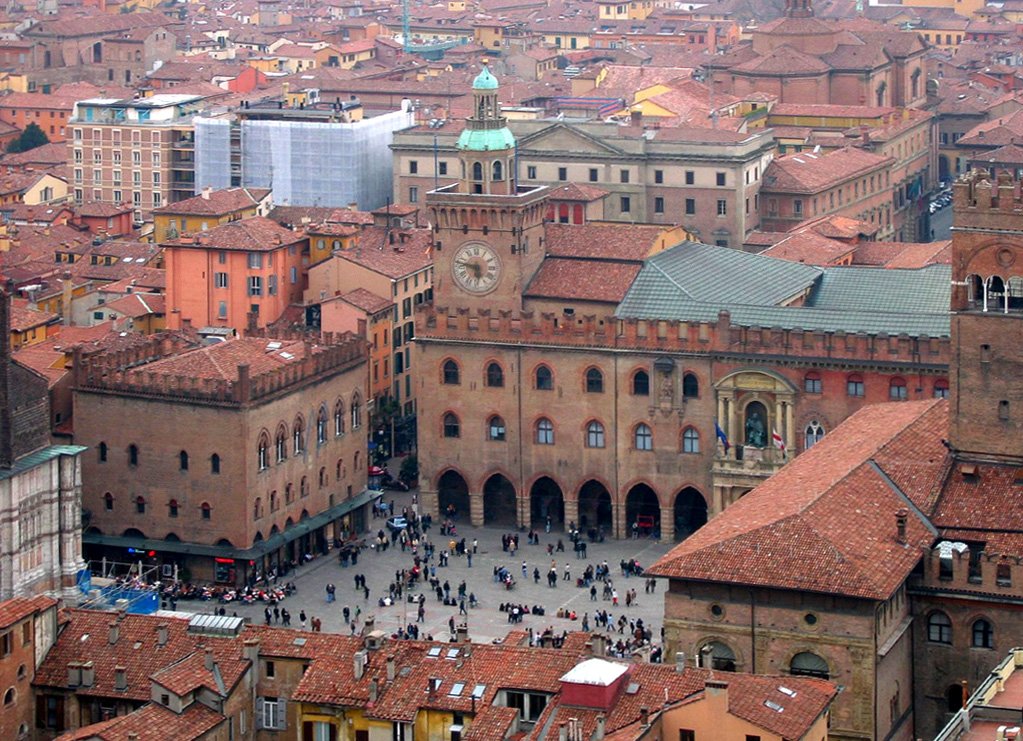
Bologna’s University Quarter is unlike anywhere else I’ve been.
The University of Bologna was founded in 1088, making it the oldest university in Europe.
The courtyards are filled with students studying, debating, and just hanging out like students have been doing here for nearly 1000 years.
I got completely lost trying to find the main library my first time there.
The buildings all look similar, and the medieval street layout doesn’t help with navigation.
But getting lost was actually the best part – I discovered tiny courtyards, hidden cafes, and street art that I never would have found otherwise.
The student bars in this area are fantastic for aperitivo.
The prices are reasonable, the atmosphere is lively, and you’ll get a real taste of modern Bologna life.
Must-See: Archiginnasio Library (free entry), Anatomical Theatre (€3), and the various university courtyards that are open to the public.
6. Discover Bologna’s Porticoes (UNESCO World Heritage)
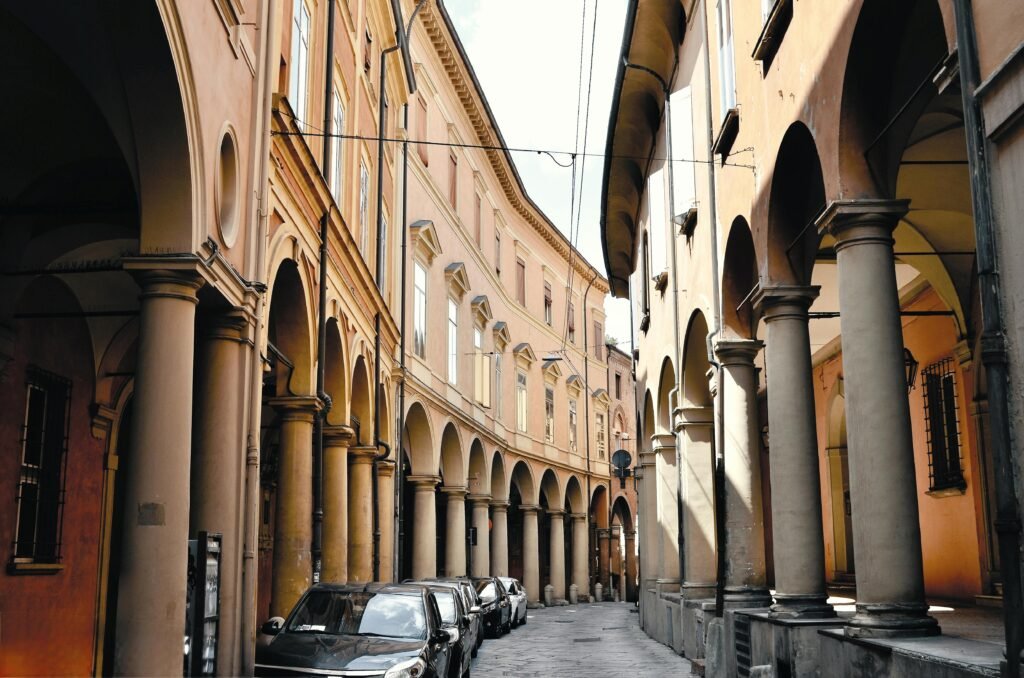
Bologna’s porticoes are absolutely magical, and I’m not just saying that because they saved me from getting soaked in an unexpected rainstorm!
These covered walkways stretch for over 40 kilometers throughout the city, and they’re a UNESCO World Heritage site as of 2021.
The portico to the Sanctuary of San Luca is the longest in the world at 3.8 kilometers. I attempted to walk the entire thing once, and let me tell you – it’s more of a workout than you’d expect!
The uphill climb gets pretty intense, but the views along the way are incredible.
Each portico has its own character and architectural style.
Some are simple brick structures, while others are elaborate affairs with painted ceilings and decorative columns.
I found myself constantly looking up, which led to a few embarrassing moments of walking into other pedestrians.
Photography Tip: Early morning or late afternoon provide the best lighting for photos. The interplay between light and shadow is absolutely stunning.
7. Experience Bologna’s Aperitivo Culture
Aperitivo in Bologna isn’t just a drink – it’s a whole cultural experience that I completely fell in love with.
The concept is simple: between 6 PM and 8 PM, you order a drink and get free appetizers.
But the reality is so much more than that.
My first aperitivo experience was at Osteria del Sole, and I had no idea what I was doing.
I ordered a Spritz (when in Italy, right?) and then just stood there awkwardly until a friendly local explained that I needed to grab a plate and help myself to the food spread.
The atmosphere during aperitivo hours is incredible.
The bars fill up with people unwinding after work, students celebrating the end of classes, and tourists trying to figure out the social customs.
Everyone’s talking, laughing, and sharing plates of food.
The best part? It’s incredibly affordable.
Most places charge €8-12 for a drink, and the food is included.
You can easily spend 2-3 hours socializing for less than you’d pay for a single course at dinner.
8. Tour the Palazzo dell’Archiginnasio
The Palazzo dell’Archiginnasio is one of those places that makes you feel like you’re in a Dan Brown novel.
This 16th-century building served as the main university building until 1803, and it’s absolutely packed with history.
Walking through the main corridor, you’re surrounded by thousands of coats of arms representing students who studied here over the centuries.
The Anatomical Theatre is the real showstopper.
This carved wooden amphitheater is where medical students watched dissections, and it’s simultaneously beautiful and slightly creepy.
The professor’s chair is flanked by statues called “Spellati” (the skinned ones) – anatomical figures that are incredibly detailed and honestly a bit disturbing.
The Stabat Mater Hall is gorgeous, with its painted ceiling and elegant proportions. It’s still used for concerts and lectures, so you might get lucky and catch a performance while you’re there.
Visiting Info: €3 entry fee, open Monday-Friday 10 AM-6 PM, Saturday 10 AM-7 PM, Sunday 10 AM-6 PM. Free guided tours available in multiple languages.
9. Explore the Modern FICO Eataly World
FICO Eataly World is like Disneyland for food lovers, and I mean that in the best possible way.
This massive agrifood theme park opened in 2017.
The scale is incredible – 25 acres dedicated to Italian food production, with working farms, restaurants, shops, and interactive exhibits.
The live animal farm section was unexpectedly fascinating.
Seeing the cows that produce Parmigiano Reggiano, the pigs that become prosciutto, and the fields where the wheat for pasta grows gives you a completely different appreciation for Italian cuisine.
The production demonstrations are amazing.
I watched mortadella being made, pasta being rolled, and cheese being aged. The workers are happy to explain the processes, and you can taste products at various stages of production.
My favorite part was the gelato laboratory.
They make gelato from scratch throughout the day, and you can watch the entire process from pasteurization to churning.
The flavors change based on seasonal ingredients, and everything is made with ingredients from the park.
Practical Tips: Take the free shuttle from Bologna Centrale station. Plan for at least 4-5 hours. Entry is free, but you pay for food, drinks, and activities separately.
10. Relax in Bologna’s Beautiful Parks and Gardens
After all that urban exploration, sometimes you need a break from the medieval streets and bustling markets. Bologna has some absolutely gorgeous green spaces that locals use for picnics, jogging, and just escaping the city energy.
Giardini Margherita is Bologna’s Central Park, and it’s where I go whenever I need to recharge.
This 26-hectare park was designed in the English garden style, with winding paths, beautiful trees, and several small lakes that reflect the sky perfectly.
The park has several cafes and gelato stands, but I always recommend bringing a picnic from the markets.
Finding a spot under the trees with some local cheese, bread, and wine is one of my favorite Bologna experiences.
Villa Ghigi Park offers something completely different – it’s this beautiful hillside park with incredible views over the city. The walking trails wind through woods and meadows, and you can see the Two Towers in the distance framed by rolling hills.
I discovered this park completely by accident when I was trying to find the San Luca sanctuary and took the wrong path. Getting lost led me to these amazing viewpoints that aren’t mentioned in any guidebooks.
The Montagnola Park is smaller but perfectly located near the train station. If you have some time before catching a train, it’s a lovely place to sit and reflect on your Bologna experience. The park has this interesting history – it was built on the site of a demolished fortress.
Best for Picnics: Giardini Margherita. Best for Views: Villa Ghigi. Most Convenient: Montagnola Park near the train station.
Final Thoughts of Things to do in Bologna
Bologna doesn’t beg for your attention — it rewards it.
It’s not about checking off tourist boxes. It’s about walking under porticoes you didn’t expect, learning pasta secrets from someone’s grandmother, and realizing the quiet beauty of a city that’s been teaching, feeding, and inspiring for centuries.
Let yourself get lost. Ask questions. Talk to locals.
And definitely climb that tower, even if your legs scream the whole way up.
This isn’t just another Italian stop.
Bologna is the kind of city that becomes part of your story because Bologna completely worth visiting.
Ready to dive in?
Pack your curiosity, bring comfortable shoes, and prepare to fall in love one plate of tagliatelle at a time.

